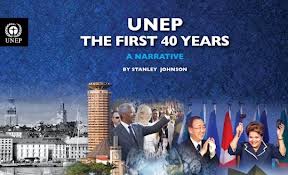UNEP at 40
Today
I saw that my friend Stanley Johnson has a new book out 'UNEP - The First 40 years' to coincide with the first meeting of UNEP as a universal membership
organization in Gigiri just outside Nairobi.
Stanley
is an Ambassador for the Convention on Migratory Species and I have at least
two other books of his on my shelf. I have to say my favorite is 'Stanley I Presume?'
a wonderful tour de force of his life from travelling from London to
Afghanistan on a motor bike to his time in the European Union as an MEP and as
a civil servant, and association with the Rockefeller Commission on Population,
but I digress.
In
all the meetings around Rio+20 last year there perhaps wasn't enough time to
look at UNEP at 40 and see what it had achieved. This book goes someway to
giving a wider audience the chance to read and appreciate what it has achieved
and what challenges it faced and is still facing in trying to be the
environmental consensus for the world. This book is very well worth getting
hold of.
A
little from what I, Michael Strauss with Maurice Strong wrote about the
creation of UNEP in Only One Planet -
The Long Road via Rio to Sustainable Development (Earthscan, 2012).
In what was the
first intergovernmental organization set up to address the environment in 1972
it is interesting to note that the new programme
was kept weak by a group of European countries including: Britain, the US,
Germany, Italy, Belgium, the Netherlands and France.
The group was
concerned that any new environmental regulations would have an impact on trade.
They also wanted to ensure that UNEP did not have a large budget as it would
then be restricted on what it could do.
In a paper
written for what was known as the
Brussels group in September 1971 the UK government said that a:
"new and
expensive international organization must be avoided, but a small effective
central coordinating mechanism ... would not be welcome but is probably
inevitable".
(Hamer, 2002)
The new UNEP was
empowered to investigate problems and recommend strategies to solve them, but
it was not authorized to implement those strategies on the ground. It was empowered
to research, but not to implement any of the actions with programmes on the
ground. While other UN bodies – such
as the United Nations Development Programme (UNDP) – were set up precisely for
project design and implementation, UNEP was expressly limited from providing
services. Although UNEP carried the word ‘programme’ in its name, it was not
established as a UN programme-level agency.
Even though a member of the ‘Brussels Group’ perhaps under-appreciated
is the leadership role the United States, under President Richard Nixon, had
played in the follow-up to Stockholm. The US wanted to host UNEP in
Washington; this would have had a profound impact on the ability of the
organization to interface with the World Bank and UNDP. The US wasn’t the only
country wanting to host the new UN programme. India and Kenya also offered to
host it
But
in international policy, 1972 was a time of transition. The era of colonialism
had just ended with the establishment of newly independent nations in Africa, Asia
and the Pacific in the 1950s and 60s. There was intense competition between the
US and the Soviet Union to win diplomatic support from those nations. For those
countries – and for the emerging political bloc of the Third World, or ‘non-aligned’
movement (NAM) – it had become a point of contention that all of the major UN
agencies were based in Northern-hemisphere, developed nations.
The
previous year UNIDO was created and was established in Vienna. So it was widely
agreed that the new organization should be housed in a developing country. The
two developing countries that wanted to host were India and Kenya.
Despite the consensus, many developed countries were
worried about the choice of Kenya. It was distant from other intergovernmental
organizations that it needed to work with and the telecommunications system
into and within Nairobi was notoriously inefficient. Other concerns included the ability to attract
qualified staff and basic questions of personal security. These were complex
matters that needed to be addressed, but even mentioning such issues risked
touching on deep regional sensitivities.
Partly because of his reputation for solving
logistical and political challenges, Maurice Strong was approached to be the
new organization’s first Executive Director. Prime Minister Pierre Elliott
Trudeau of Canada agreed to let Strong be the Executive Director for one term
to get UNEP running, as opposed to returning to head CIDA.
One of the first things UNEP did was to establish an
outer limits program which looked at global risks that needed to be addressed. One of the first to be addressed was in 1973
climate change. UNEP brought together a meeting of scientists to review the
evidence on the issue this gave UNEP an early leadership role on the
issue.
In 1975, Maurice Strong resigned to become CEO of
Petro-Canada. UNEP’s Deputy Director, Mustapha Tolba, a biologist who’d led
Egypt’s delegation to Stockholm, was appointed to succeed Strong. He served
until 1992, playing a critical leadership role in creating a landscape of multilateral
environmental agreements.
It is interesting to reflect that 40 years on it was
some of the same governments that wanted to keep UNEP weak during the Rio+20
process now wanted to see it raised to the status of a World Environmental
Organization.





Comments
Post a Comment